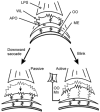A kinetic study of blinking responses in cats
- PMID: 12665614
- PMCID: PMC2342921
- DOI: 10.1113/jphysiol.2002.033258
A kinetic study of blinking responses in cats
Abstract
Reflexively evoked and eye-related eyelid responses were recorded using the search coil in a magnetic field technique in alert cats. The downward phase of a blink was a large (up to 21 deg), fast (up to 2000 deg s-1) eyelid displacement in the closing direction, with an almost fixed rise time duration (15-20 ms); its maximum velocity was achieved in ~10 ms. Upward eyelid motion was separated into two phases. The first phase consisted of a fast eyelid displacement, with a short duration (approximately 30 ms) and a maximum velocity up to 900 deg s-1. The second phase had an exponential-like form, lasting for 200-400 ms, and a maximum velocity ranging between 30 and 250 deg s-1. Maximum blink velocity in the downward direction was linearly related to maximum velocity of the first upward phase. The first phase in the upward direction was never observed if the eyelid stayed closed for a long period (> 50 ms) or moved slowly in the closing direction before it started to open. In these two cases, the upswing motion of the blink reflex contained only the exponential-like movement characteristic of the second upward phase, and maximum velocity in the downward direction was not related to that of the eyelid upward displacement. Mean duration of eyelid downward saccades was approximately 130 ms, and their peak velocities ranged between 50 and 440 ms. A physiological model is presented explaining the active and passive forces involved in both reflex and saccadic eyelid responses. A second-order system seems to be appropriate to describe the postulated biomechanical model.
Figures






Similar articles
-
Kinematics of spontaneous, reflex, and conditioned eyelid movements in the alert cat.J Neurophysiol. 1995 Jul;74(1):226-48. doi: 10.1152/jn.1995.74.1.226. J Neurophysiol. 1995. PMID: 7472326
-
Upper eyelid movements measured with a search coil during blinks and vertical saccades.Invest Ophthalmol Vis Sci. 1991 Dec;32(13):3298-305. Invest Ophthalmol Vis Sci. 1991. PMID: 1748560
-
Quantitative measurement of upper eyelid movements.Jpn J Ophthalmol. 1987;31(2):255-64. Jpn J Ophthalmol. 1987. PMID: 3669426
-
Physiology of the eyelid motor system.Ann N Y Acad Sci. 2003 Oct;1004:1-9. doi: 10.1196/annals.1303.001. Ann N Y Acad Sci. 2003. PMID: 14662442 Review.
-
Eyelid movements in health and disease. The supranuclear impairment of the palpebral motility.Neurophysiol Clin. 2004 Feb;34(1):3-15. doi: 10.1016/j.neucli.2004.01.002. Neurophysiol Clin. 2004. PMID: 15030796 Review.
Cited by
-
Recruitment in retractor bulbi muscle during eyeblink conditioning: EMG analysis and common-drive model.J Neurophysiol. 2009 Oct;102(4):2498-513. doi: 10.1152/jn.00204.2009. Epub 2009 Aug 12. J Neurophysiol. 2009. PMID: 19675295 Free PMC article.
-
The origin of blinking in both mudskippers and tetrapods is linked to life on land.Proc Natl Acad Sci U S A. 2023 May 2;120(18):e2220404120. doi: 10.1073/pnas.2220404120. Epub 2023 Apr 24. Proc Natl Acad Sci U S A. 2023. PMID: 37094121 Free PMC article.
-
The Role of Cerebellar Intrinsic Neuronal Excitability, Synaptic Plasticity, and Perineuronal Nets in Eyeblink Conditioning.Biology (Basel). 2024 Mar 21;13(3):200. doi: 10.3390/biology13030200. Biology (Basel). 2024. PMID: 38534469 Free PMC article. Review.
-
Conditioned eyelid movement is not a blink.J Neurophysiol. 2010 Feb;103(2):641-7. doi: 10.1152/jn.00631.2009. Epub 2009 Nov 25. J Neurophysiol. 2010. PMID: 19939960 Free PMC article.
-
Associative and non-associative blinking in classically conditioned adult rats.Physiol Behav. 2009 Mar 2;96(3):399-411. doi: 10.1016/j.physbeh.2008.11.008. Epub 2008 Nov 27. Physiol Behav. 2009. PMID: 19071146 Free PMC article.
References
-
- Aramideh M, Ongerboer De Visser BW, Vander Werf F, Bour LJ, Brands JWM, Spielman JD. The inhibitory response of levator palpebrae muscle to evoked blink reflexes. In: Valls-Solé J, Tolosa E, editors. Brainstem Reflexes and Functions. S. A., Madrid: Litofinter; 1998. pp. 89–98.
-
- Becker W, Fuchs AF. Eyelid-eye coordination during vertical gaze changes in man and monkey. J Neurophysiol. 1988;60:1227–1252. - PubMed
-
- Berdún-Seijo JI, Roa LM, Trigo JA. Análisis del parpadeo mediante el plano de estados. Proceedings of CASEIB. Madrid: 2001. pp. 77–80.
-
- Björk A, Kugelberg E. The electrical activity of the muscles of the eye and eyelid in various positions and during movement. Electroencephalogr Clin Neurophysiol. 1953;5:595–602. - PubMed
-
- Delgado-García JM, Del Pozo F, Baker R. Behavior of neurons in the abducens nucleus of the alert cat - I. Motoneurons. Neuroscience. 1986;17:929–952. - PubMed
Publication types
MeSH terms
LinkOut - more resources
Full Text Sources
Miscellaneous

